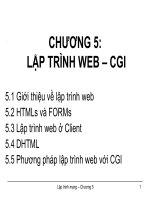Kendall7E ch05
Bạn đang xem bản rút gọn của tài liệu. Xem và tải ngay bản đầy đủ của tài liệu tại đây (1.88 MB, 40 trang )
Information
Gathering:
Unobtrusive Methods
Systems Analysis and Design,
7e
Kendall & Kendall
© 2008 Pearson Prentice Hall
5
Learning Objectives
• Recognize the value of unobtrusive methods
•
•
•
•
for information gathering
Understand the concept of sampling for human
information requirements analysis
Construct useful samples of people,
documents, and events for determining human
information requirements
Create an analyst’s playscript to observe
decision-maker activities
Apply the STROBE technique to observe and
interpret the decision-maker’s environment
and their interaction with technologies
Kendall & Kendall
5-2
Unobtrusive Methods
• Less disruptive
• Insufficient when used alone
• Multiple methods approach
• Used in conjunction with
interactive methods
Kendall & Kendall
5-3
Major Topics
• Sampling
• Quantitative document analysis
• Qualitative document analysis
• Observation
• STROBE
• Applying STROBE
Kendall & Kendall
5-4
Sampling
• A process of systematically
selecting representative elements
of a population
• Involves two key decisions:
• What to examine
• Which people to consider
Kendall & Kendall
5-5
Need for Sampling
The reasons systems analysts do
sampling are:
• Containing costs
• Speeding up the data gathering
• Improving effectiveness
• Reducing bias
Kendall & Kendall
5-6
Sampling Design
• To design a good sample, a systems
analyst must follow four steps:
• Determining the data to be collected or
described
• Determining the population to be
sampled
• Choosing the type of sample
• Deciding on the sample size
Kendall & Kendall
5-7
Figure 5.1 Four main types
of samples the analyst has
available
Kendall & Kendall
5-8
The Sample Size Decision
• Determine the attribute
• Locate the database or reports in which
the attribute can be found
• Examine the attribute
• Make the subjective decision regarding
the acceptable interval estimate
• Choose the confidence level
• Calculate the standard error
• Determine the sample size
Kendall & Kendall
5-9
Figure 5.2 A table of area under a normal
curve can be used to look up a value once the
systems analyst decides on the confidence level
Kendall & Kendall
5-10
Calculate the Standard Error
of the Proportion
p = i/z
i = interval estimate
z = confidence
coefficient found
in the confidence
level lookup table
Kendall & Kendall
5-11
Determine the Sample Size
p(1-p)
σp = standard error
ρ = the proportion of the population
having the attribute
Kendall & Kendall
5-12
Example: A. Sembly
Company
• Determine that you are looking for orders
with mistakes
• Locate order forms from the past six months
• Examine order forms and conclude that
p=5%
• Subjective decision of acceptable interval i =
± 0.02
• Look up confidence coefficient z-value = 1.96
• Calculate p = i / z = 0.02/1.96 = 0.0102
• Determine n; n = 458
Kendall & Kendall
5-13
Investigation
• The act of discovery and analysis
of data
• Hard data
• Quantitative
• Qualitative
Kendall & Kendall
5-14
Analyzing Quantitative
Documents
• Reports used for decision making
• Performance reports
• Records
• Data capture forms
• Ecommerce and other transactions
Kendall & Kendall
5-15
Reports Used for Decision
Making
• Sales reports
• Production reports
• Summary reports
Kendall & Kendall
5-16
Figure 5.3 A performance
report showing improvement
Kendall & Kendall
5-17
Figure 5.4 A manually
completed payment record
Kendall & Kendall
5-18
Data Capture Forms
• Collect examples of all the forms in
use
• Note the type of form
• Document the intended distribution
pattern
• Compare the intended distribution
pattern with who actually receives
the form
Kendall & Kendall
5-19
Figure 5.5 Questions to ask about official
and bootleg forms that are already filled
out
Kendall & Kendall
5-20









